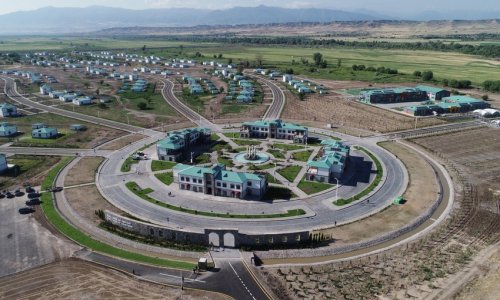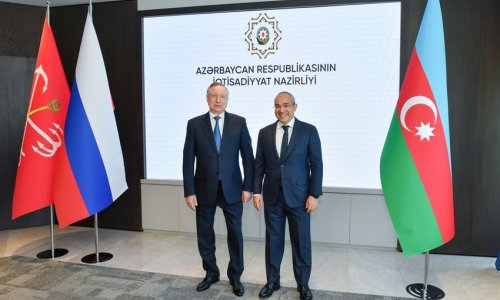(EconomistIntelligence Unit) -- Speculation regarding the futureof Azerbaijan's oil sector has intensified since 2012, when asharp fall in output at the giant Azeri-Chirag-Guneshli (ACG)oilfields raised fears that production could be entering a period ofrapid decline.
Despite an acceleration in the rate of decline ofoil production in January-February this year, our forecastremains that oil output will essentially be flat in 2014-18.From 2019 the decline in the oil sector will be partiallyoffset by the launch of the Shah Deniz II gasfield, which couldlead to natural gas accounting for around one-fifth of totalexports by 2020.
Overallproduction declined by 4.9% in 2012, following a reductionof over 10% in 2011. Year-on-year output continued to fall intothe first quarter of 2013, but recovered in the later part of theyear, resulting in annual production of 43.5m tonnes, up by 0.2%compared with 2012. However, year-on-year oil output started todecline again in December 2013, falling by 3%, and contractedby a further 4.8% year on year in January-February 2014.
The recentdecline in output is in part a result of temporary factorsrelated to repair works at the ACG field, which has reducedproduction at some platforms. In addition, a fire at the Bulla Denizoil platform-operated by the State Oil Company of the AzerbaijanRepublic (SOCAR)- which lasted for nine weeks, from August toOctober 2013, has also had a belated effect on output. Theincident did not immediately damage output volumes, as reserveswere used to offset the shortfall, but it is now affectingproduction.
Falteringproduction has been compounded by poor practice in the early2000s, when Azerbaijan's oil industry expanded quickly. Contemporarytechnological standards require that the voids left in thereservoirs should be filled in with water after oil is pumped, inorder to preserve field pressure and enable sustained long-termproduction. However, in order to extract as much fuel as possiblein a short period of time this technique was not alwaysimplemented. As a result, numerous cavities formed within the oilwells, reducing pressure in the reservoir and pushing up the cost offurther extraction.
Nevertheless,most forecasts for future oil production anticipate thatAzerbaijan's oil production will remain broadly flat in 2014-18.This view is supported by major international organisations,whose findings have been based on interviews with officialsand leading figures in the Azerbaijani oil industry. The IMF'sArticle IV report on Azerbaijan, published in June 2013,appears to be have been based on a baseline forecast that oil outputwill rise modestly in 2014 and then stay flat until 2020.
Areport published by the World Bank in 2012 provided a more optimisticoutlook, projecting that oil output would reach 65m tonnesor 1.3m barrels/day (b/d) by 2016, before declining to around910,000 b/d by 2020. We are sceptical regarding this scenario,given the performance of the oil sector in 2013. Our current economicforecast is based on production remaining flat in 2014,rising by 2-3% in 2015, then declining at an annual average of2% a year to 2018.
Outlook forthe gas sector
With oiloutput set to remain flat or even decline modestly in 2014-18,the government has placed increasing emphasis on the prospectsfor gas production to support continued growth in the country'sextractives sector. Azerbaijan's gas projects have attractedsignificant international attention, primarily because they willin principle enable the EU to diversify its sources of natural gasaway from Russia. The Trans-Anatolian pipeline (TANAP),which crosses Georgia and Turkey, and the Trans-Adriatic pipeline(TAP) will deliver gas from Shah Deniz II to southern Europe,bypassing Russia. However, in the short to medium term at least theimpact of this new energy corridor will be small.
TANAP/TAPwill deliver 10bn cu metres of gas to the EU in the firststage, and a further 6bn cu metres will be supplied to Turkey.According to International Energy Agency estimates, 10bn cu metresof gas accounts for less than 2% of Europe's total demand in2012.
Nevertheless,the expansion of gas exports will provide a boost toAzerbaijan's economic growth in 2019-20, when Shah Deniz II comes onstream. In 2012 Azerbaijan exported 6.6bn cu metres of gas, at avalue of US$1.6bn and an implied gas price of around US$240 per1,000 cu metres. This was equivalent to just under 5% of totalexports. Once Shah Deniz II is launched, gas exports shouldeventually rise to around 20bn cu metres. The pricing structurefor Azerbaijan's gas exports to Europe is not known and future gasprices are subject to significant uncertainty.
Nevertheless,it seems likely that Azerbaijan will be able to command ahigher price from European consumers for its gas. As a result,following the launch of Shah Deniz II, the share of gas in totalexports could rise to 15-20%.
ANN.Az











